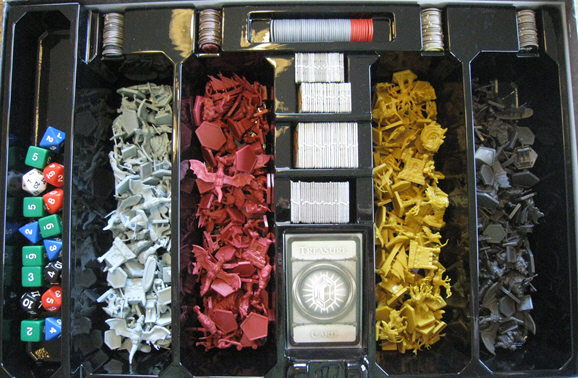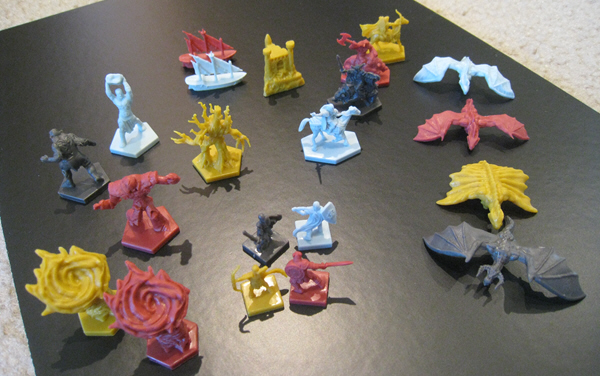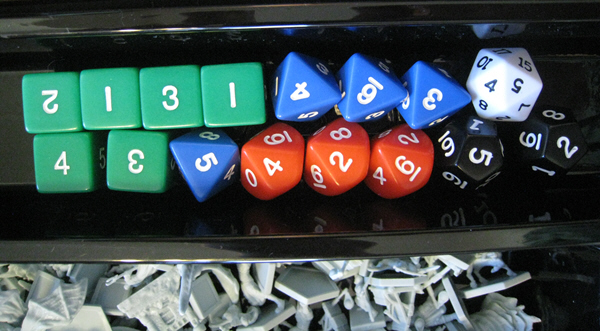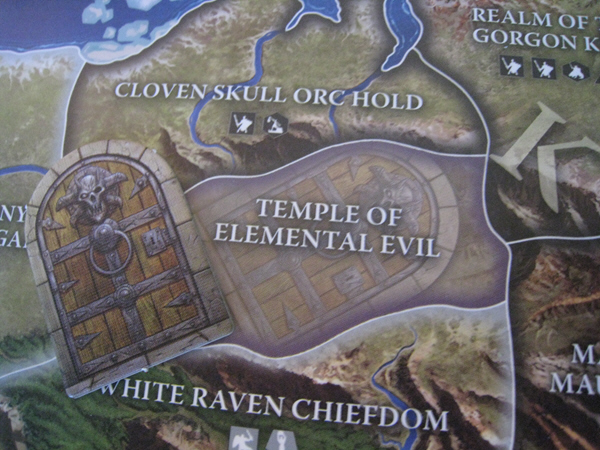Dungeons & Dragons: Conquest of Nerath
 Dungeons & Dragons: Conquest of Nerath. Boardgame Review. Publisher: Wizards of the Coast: Designers: Richard Baker, Mons Johnson, Peter Lee $79.99
Dungeons & Dragons: Conquest of Nerath. Boardgame Review. Publisher: Wizards of the Coast: Designers: Richard Baker, Mons Johnson, Peter Lee $79.99
Passed Inspection: Fast and furious and fun from the start. Complex enough to be strategic but simple enough to appeal to both casual and hardcore gamers. Great combat and fun dungeon delving mechanics!
Failed Basic: A long game, even when playing the short version. Turns can take a long time, leading to some downtime. Flimsy cardstock for the event cards despite all of the other excellent components. Best played with four players.
{default}At some point, nearly all fans of both fantasy role-playing and historical warfare ponder the same hypothetical scenario – what would have happened if the Axis powers had access to black dragons?
Given the similarities between Wizards of the Coast’s new conquer-the-world boardgame Dungeons & Dragons: Conquest of Nerath (hereafter Conquest of Nerath) to the excellent old classic Axis & Allies, you might wonder if some of the WotC designers used this hypothetical as their guiding principle! Joking aside, Conquest of Nerath offers a cramped world, fully populated with four different armies set to immediately duke it out for gold, magical artifacts, and territory across the D&D fantasy realm of Nerath. A fast and furious ride from the very start, Conquest of Nerath manages to take some very familiar "tried-and-true" aspects of conquest boardgaming and mix them with some neat new rules drawn primarily from the world of pen-and-paper roleplaying (and a little Magic: The Gathering) to create a simple but elegant slugfest that should appeal to wargamers and fantasy gamers alike.

Good and Evil resting peacefully side-by-side in a gaming tray.
The premise of Conquest of Nerath is that each of the 2–4 players takes control of one of the four major Nerathian kingdoms in a struggle for dominance. The four sides are split between two main "Evil" or "Good" factions, with the undead Dark Empire of Karkoth and the orc- and goblin-led Iron Circle on the evil side and the elvish mariners of the Vailin Alliance and the dwarven and human feudal states of the Nerathian League making up the beleaguered good guys. While the game can be played as a free-for-all between all sides, it is designed primarily to be a team game of Good vs. Evil, much like Axis & Allies.

Only the most unwise do not quake and tremble before this mighty force!
The team aspect of the game is clearly the game’s strong point, and the map is balanced symmetrically with allies playing across the board from one another and separated by enemy lands and forces. The unfortunate aspect of the game’s emphasis on alliance play is that the game cannot be played without fielding all four sides, so games with two players will see both players taking control of the entire Evil or Good side and three player games will always result in a 2v1 scenario (with one player taking control of an entire faction). In a more complicated game, controlling two forces might be a deal-breaker, however, Conquest of Nerath’s rules are simple enough to make this both easy and fun. Still, for the best experience, it is preferable to have the full complement of four players.
Each side has access to an impressive nine different types of units. While this may sound cumbersome, the units are easy to understand and are completely identical for each side (i.e. the factions do not, initially, have any racial differences in units). There are five different land pieces, including weak foot soldiers, siege engines, castles, gigantic monsters, and two types of heroes – wizards and fighters. Each side can field two types of flying forces, the storm elemental and—to be expected in a D&D game—dragons. Players can also make use of warships to fight on the seas or ferry their land units across Nerath’s large oceans.

It wouldn’t be D&D without the funny-shaped dice.
As a game of world conquest, it should be expected that a majority of the player’s time will be spent in battle and that the rules for battle need to be exciting and fun. In this regard, Conquest of Nerath truly delivers! In a move of sheer design brilliance, the designers made the number that every unit needs to score a "hit" the same—a 6. Instead of forcing players to do mental math with hit scores or modifiers, The game provides different dice for each unit, changing the hit probability by changing the dice each unit uses.
It wouldn’t be a D&D game without a slew of neat dice, and all types are present. For example, a foot solider rolls a d6 to hit (meaning only a 1-in-6 chance) while siege engines roll a d8 and heroes roll d10. Of course, the dragon rolls the archetypical D&D die—the d20. What this means is that combat happens fast and is easy to calculate, each player gathers his or her dice, rolls, and sees how many rolls are six or higher. Hits are counted, then the units’ owner gets to assign the hits received (making the cheap foot soldiers, who can’t hit a barn, useful for cheap fodder). In a game where combat rolling makes up the majority of the time, this system makes everything easy and fast but still allows for a "groggy" calculation of hit probabilities when planning a grand strategy.
To add variety beyond simple hit-percentages, most units have a "special power" to make battle even more interesting. For example, siege engines roll two d8 when attacking, but only one d8 when defending and dragons can absorb one hit of damage and need a second hit to be destroyed. Wizards get the enormously powerful "First Strike" ability, allowing them to roll their combat dice first, assigning their hits before any other unit gets to battle. It all comes together very well, and these special abilities make deciding what unit to use in every situation a large part of the fun.

An oldie but a goodie.
While Conquest of Nerath would have interesting combat and be a fun, if relatively unoriginal, game of pushing units across a map, but it also mixes up this formula further by adding—ta-da!—dungeon delving. Dungeon delving is one of the most interesting parts of Conquest of Nerath and the major place where the relatively balanced sides can become customized and imbalanced. In various places on the board are dungeon spaces which cannot be entered by normal units, except for heroes (fighters and wizards). Each dungeon space has a number of "door" tokens representing the monsters that reside in the dungeon. Any number of hero units can go into the dungeon and then battle monsters within. There is a high degree of random chance here, some monsters roll a few d6, while others (like the dreaded beholder) might roll a d8 AND d20! The dice also represent the monster’s hitpoints, and some monsters have special abilities (like can only be hit by rolls of 7+) or award money for killing.
Once the dungeon is cleared (heroes fight ALL monster tokens at once), if the player is victorious he or she can draw a treasure card. Treasure provide a variety of benefits that effect that player’s entire army, such as fighters get first strike or you may "teleport" one wizard from a friendly space to another each turn. Treasures also award victory points, so hunting treasures is a viable path to success. Dungeon delving is a gamble, but often one that pays huge dividends. Nothing quite trumps seeing an opponent’s face when he realizes the treasure you looted suddenly allows your fighters to move three spaces into his capital!
The four sides are mostly balanced, although each has access to unique decks of event cards to offset the turn order. Karkoth always goes first and Nerath always goes last each round, so the Nerath player will likely feel beaten upon until his or her turn arrives. To balance this, Nerath gets much more powerful event cards (players draw a card per turn and start with two), while Karkoth’s cards are weaker. These cards can certainly sway a battle, and lend some additional strategy and unpredictability to the game without being unfair.
That being said, turns can last a long time and there is significant downtime while waiting for your turn to come up. In particular, the Iron Circle (which goes third) and Nerath will feel like spectators while they wait for Karkoth and Vailin to go. The dynamic nature of the battles makes this more palatable, but the downtime is the same sort of scope as the old classics like Risk and Axis & Allies and might frustrate players used to the round-robin style of games like Runewars or Twilight Imperium: 3rd Edition.
Conquest of Nerath is a battle from the very start. The board is highly dynamic and war breaks out from the very first move. There is practically no way to play the defensive "turtle" in Conquest of Nerath, and the game rewards aggressive maneuvers (conquering enemy homelands is the only way to get victory points and gold). Unlike other games, victory points are generated only by taking territory, it is not necessary to hold it; hit and run raiding, massive assaults, dragons flying deep into enemy territory, and huge armies are all viable paths to winning. This will rattle people who are "empire builders" and sheepish players will get steamrolled, but the game keeps the pressure on and the adrenaline flowing. There are three different game lengths to chose, the short alliance game taking 2-3 hours, the medium game 4-5 and the long game a much more epic length.

Production quality is excellent, which is to be expected from a WotC product. The units, despite being identical in the rules, all have slightly different molds, with the black dragons looking undead, the gold dragons having fairy-like wings, the evil factions riding dire wolves and the good riding horses. These distinctions are meaningless for play but a nice touch. The box insert is one of the finest ever encountered in a game like this, providing excellent storage for the tokens, pieces, cards, and dice. The only possible complaint is that the card stock seems to be a bit thin and flimsy (a surprise for the makers of Magic) but this can be rectified by sleeving the cards.

The Event Cards.
To put it briefly, Conquest of Nerath is an excellent blast from the past that mixes the best parts of the conquer-the-world type games of Risk and Axis & Allies with some innovative parts of other genres to make a game far more strategic and fun that its predecessors without being much more complicated. The game can be taught in less than ten minutes, is easy to set up, and the fun begins nearly immediately. While not particularly a "thinking game" and certainly prone to the vagaries of dice rolls and lucky card draws, Conquest of Nerath provides a casual wargaming experience that will likely feel both nostalgic and new at the same time. The alliance play, clearly the winning component of the game, allows for synergy and interaction between players and gives the feeling of a desperate struggle of good versus evil. Although many hardcore boardgamers pretend they have moved past the down-and-dirty dice fest, Conquest of Nerath is a beautifully composed and elegantly designed reason to take a trip down memory lane!
Armchair General Rating: 91%
Solitaire Suitability: 2 of 5
About the Author:
Christopher Beck is a PhD candidate in Medieval History, studying Mediterranean seafaring, trade, and civic governance. Beck is a long time board and video gamer since the days the Atari was new and is an avid fan of role-playing, grand strategy, science fiction and most anything Lovecraft. His boardgame collection now takes up its own room, much to his wife’s chagrin. Favorite boardgame publishers include Fantasy Flight, Flying Frog Productions, and the now long-lost Avalon Hill. His current project is reading the Necronomicon in Latin.


0 Comments
Trackbacks/Pingbacks